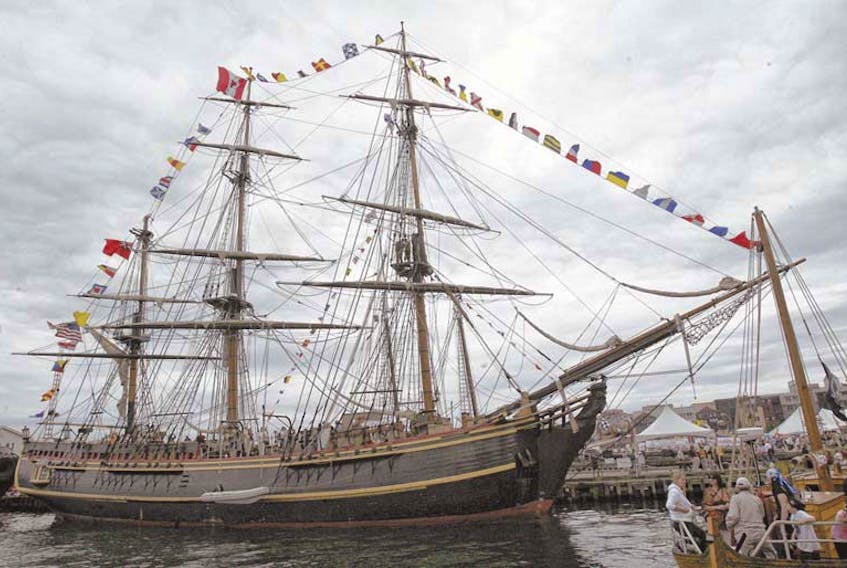Editor's Note: Today marks the 60th anniversary of the launch of the tall ship Bounty in Lunenburg. The following is adapted from Bounty – The Greatest Sea Story Of Them All, by Halifax author Geoff D’Eon.
GEOFF D’EON
By the time Metro Goldwyn Mayer came calling in 1960 looking for an ocean-going ship required for their movie Mutiny On The Bounty, boat-building was an essential part of Lunenburg’s DNA.
While ship construction had changed substantially in the 20th century, there were still craftsmen in the town supremely skilled in the building of wooden boats. The same shipyard that had launched the original Bluenose in 1921 — Smith and Rhuland — was a busy enterprise. When news of their successful Bounty bid arrived, Smith and Rhuland were in the process of completing seven vessels, and were about to start on two 60-foot longliners. But building Bounty — a 400 ton brigantine — this was an altogether different challenge, requiring a combination of skills the yard hadn’t seen in a generation.
The contract called for Smith and Rhuland to deliver a fully-rigged, ocean-going 118-foot wooden ship in just six months. She would be based on the plans for the original Bounty, a Royal Navy ship famous for the mutiny of her crew in 1789. To outward appearances, the new Bounty would be a dead ringer for the original, but the 20th-century version would be adapted for her high-profile job. She would be longer and wider than the original to accommodate camera platforms, engines and other modern necessities.
Planners began drawing up materials lists: 400,000 board feet of wood; 12 tons of screw bolts; 2.5 tons of iron spikes; 1.5 tons of oakum for caulking; 10 miles of ropes; 5 on-board generators; 10,000 square feet of sail canvas; 14 tons of bar iron for long bolts; one and a half miles of wire rigging; eight pumps; six giant deep freezes for food storage; fuel and water tanks. On and on, the lists were drawn up.
Smith and Rhuland hired 120 men for the Bounty job, including every qualified carpenter they could find, 80 of them in all. Lunenburg and surrounding counties had lifetimes of ship-building experience on hand. A top-notch workforce was assembled. Bounty’s keel was laid on March 3, 1960. A launch date of Aug. 27 was set. The clock was ticking, and no delays would be acceptable. Two shifts went at it, day and night. Most of the workers had never even seen a square-rigged ship in their lives, let alone worked on one. Oldtimers were called in: 73-year-old Gordon Wentzell and 71-year-old Howard Falkenham put their retirement on hold and donned their overalls. Bounty was built inside the yard’s main shed, eventually filling the building to the rafters.
Outside the yard, a small army of local suppliers stepped up. Lunenburg Foundry and Engineering were sub-contracted to manufacture rigging, and install the two diesel engines. Dauphinee & Sons landed a huge order for hundreds of blocks and deadeyes, used to rig the ship. Charles Hebb’s sail loft got the job of cutting and stitching Bounty’s enormous canvas requirements. Hebb was the last remaining sail maker in an operation that once employed 20 men. Hebb and his assistant, Bud Lohnes, used the sailmaker’s leather palm and curved needle to finish the sail grommets and edging on the biggest order of their long careers.
Halifax Heating and Air Conditioning set about making sure Bounty’s air would be comfortable in the tropics. T. Walters and Sons, marine blacksmiths, began the huge job of crafting Bounty’s iron fittings, using traditional open-fire forging. American oak and Douglas Fir from Oregon and British Columbia was imported to augment local spruce and birch. Lunenburg’s streets buzzed with excitement as Bounty took shape. So many tourists flocked into town to get a look that Fred Rhuland had to hire a tour guide to manage the crowds, a first in the shipyard’s history.
Launch day, Aug. 27, happened on schedule. In the bright sunshine, a crowd estimated to be 10,000 strong lined the waterfront and adjacent shorelines. MacKenzie Bus Lines laid on extra vehicles to handle the crowds. People came to witness what was widely anticipated to be an historic occasion. The companies and sub-contractors involved in the project proudly took out congratulatory ads in the Halifax Chronicle Herald. Passes for the seats on the officials’ platform were the hottest tickets Lunenburg had seen in a lifetime. Premier Robert Stanfield was on hand, as well as Mayor R.G. Wood, and a bevy of guests and dignitaries.
At the podium, a tight knot of key participants gathered behind a cluster of radio microphones that carried the event live across Nova Scotia and beyond. In a clear voice, the Canadian Navy’s top brass in Atlantic Canada, Rear Admiral H.F. Pullen, set a celebratory tone:
“Today we go back 200 years to see an 18th-century ship launched and, in due course, rigged and ready for sea. All this is made possible by the skills and craftsmanship of many Lunenburgers. Truly, a wonderful achievement. May she have fair winds for all her voyages.”
Then, Mrs. Margaret Rhuland stepped up, a cloth-covered bottle in her hands. Inside the bottle: not the traditional champagne, but instead sea water from Tahiti, shipped to Lunenburg by MGM for this specific moment. Mrs. Rhuland swung her arm and smashed the bottle against the bow, giving Bounty her very first taste of the Pacific Ocean.
Slowly, as the work crew pounded wedges underneath Bounty’s hull, she started to slide down the ways. Inside the shed, the crowd shouted out three cheers. When Bounty’s stern hit the water, every horn in Lunenburg Harbour sounded off in salute, and the crowd roared their approval.
MGM’s no-nonsense representative, Jim Havens, loosened up enough to give a television interview: “The craftsmen here in Lunenburg are the best I’ve ever seen in the shipbuilding profession. They can take a raw piece of timber, put the broad axe and adze to work, and fashion out a stern post, a rudder, a frame or anything else in a short time. I think these people are to be complimented on the job they’ve done.”
Capt. Ellsworth Coggins from Dartmouth was chosen as Bounty’s captain. The crew selected to take Bounty to the film’s location in Tahiti was comprised almost completely of Nova Scotian men from seafaring towns all over the province, including Bridgewater, Parrsboro, Liverpool, Hantsport, Oyster Pond, Halifax and Dartmouth.
Two months after her launch, on Oct. 26, 1960, watched by journalists and photographers from all over the country, Bounty cast off. Three of the crew pumped out a spirited rendition of the popular song Now Is The Hour, accompanied by violin, guitar and accordion. Motoring slowly past the squat red and white lighthouse on Battery Point, Bounty had at last begun her 7,000-mile journey to Tahiti.
There, on the other side of the world, the film crew had already been assembled. Marlon Brando was warring with the producers and director over the script — early signs of what would become a nightmare for the film studio in its dealings with their lead actor. Writers were hired, then fired. The film’s director quit in frustration. Nervous MGM accountants started to add up the costs of the delays. The film started out with an enormous budget (for the time) of $10 million. It wouldn’t be enough. Not nearly enough.
Reprinted with permission of the author and Formac Publishing Ltd., Halifax.









